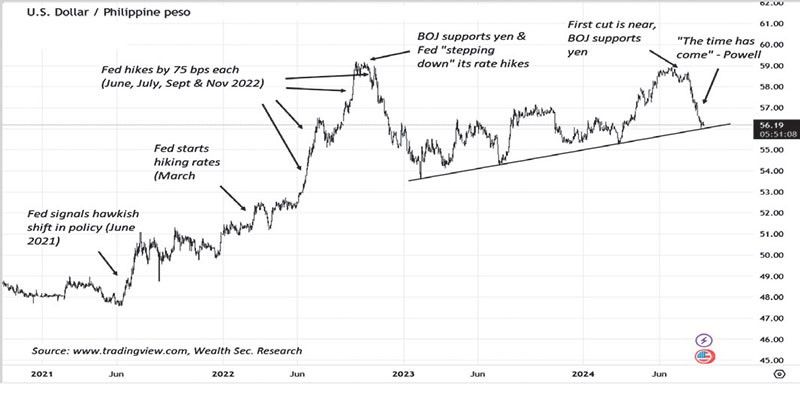The time has come

Federal Reserve Chairman Jerome Powell’s recent statement that “the time has come for policy to adjust” has set the stage for a potential reversal in the dollar’s long-term strength.
This shift could have significant implications for emerging market currencies like the Philippine peso. In fact, the Philippine peso gained four percent last month. This is its biggest monthly gain since August 2001, a total of 23 years.
The dollar’s ascent in 2021
The dollar’s path has been strongly influenced by shifts in Federal Reserve policy, most notably the hawkish pivot in June 2021. In the days following the announcement, the US dollar index (DXY) surged from around 90.5 to 92.50. The impact was immediate for emerging market currencies.
At that time, the Philippine peso hit an inflection point. The USD/PHP rate found support at 48 against the dollar. This level marked a reversal that ended a 15-month trend of the peso strengthening against the dollar. We covered this development in a previous article (see US dollar boosted by hawkish Fed, June 28, 2021).
2022: The year of dollar dominance
The dollar’s ascent accelerated in 2022, driven by a confluence of global events and the Fed’s policy decisions. The Russian invasion of Ukraine in February 2022 triggered a flight to safety and exacerbated inflationary pressures, particularly in energy and food prices.
The Fed responded with its most aggressive rate hike cycle since the 1980s, starting with a 25-bps increase in March 2022, followed by 50-bps hike in May and escalating to 75-bps hikes in June, July, September and November.
Dollar smile
The rapid rise of the US dollar grabbed headlines and rattled investors (see Dollar Smile, Sept. 12, 2022). The Fed’s aggressive tightening amid high inflation propelled the DXY from 95.67 at the start of 2022 to a peak of 114.78 in September, a 20 percent increase.
This surge pushed the euro below parity for the first time since 2002 and drove the Japanese yen to a 32-year low of 151.94 against the US dollar in October 2022. The Philippine peso also felt pressure, weakening 15 percent to a new record low of 59 against the dollar.
Peak dollar
The US dollar peaked on Sept. 28, 2022, but began its significant decline the next month. Hints by Wall Street Journal’s Nick Timiraos about a potential Fed rate hike slowdown marked a turning point. Additionally, the Bank of Japan’s intervention pushed USD/JPY down from 152 to 146 in one day. This reversal in the DXY triggered movements across FX, bonds and equities markets (see Peak Dollar?, Oct. 31, 2022). By yearend of 2022, the DXY had fallen from 114.78 to 103.52.
Dollar pain
The currency market today faces a similar inflection point. Lower US inflation and slowing economic growth solidify expectations of Fed rate cuts starting this September. This certainty, reinforced by Powell’s “the time has come” statement, has driven the DXY to its largest monthly drop this year.
The DXY is down by 2.3 percent, sparking a broad currency rally. Triggered by the unwinding of carry trades, the Chinese yuan is up by 1.8 percent in August to its strongest level this year. Meanwhile, the yen added 2.7 percent in August, bringing its two-month rally to more than 10 percent.
Peso’s biggest monthly gain in two decades
Powell’s Jackson Hole statement that “the time has come for policy to adjust” officially announces the end of the tightening cycle and the start of easing. The Philippine peso strengthened by four percent last month, its biggest monthly gain since August 2001.

Dollar at the crossroads
The US dollar is at a crossroads as market signals suggest its long-term strength may be waning. Anticipated Fed rate cuts, unwinding carry trades and a recovery in emerging market currencies are all putting pressure on the dollar.
At the same time, the stock rally is broadening beyond US tech to other sectors and other countries. This shift toward a weaker dollar has started boosting a wide range of global assets, benefitting both emerging markets and developed economies. As a result, these regions are attracting significant capital inflows. The Philippine peso’s largest monthly gain in over two decades is significant. These positive trends could potentially revitalize the Philippine stock market and mark the end of a decade-long period of underperformance.
Philequity Management is the fund manager of the leading mutual funds in the Philippines. Visit www.philequity.net to learn more about Philequity’s managed funds or to view previous articles. For inquiries or to send feedback, please call (02) 8250-8700 or email [email protected].
- Latest
- Trending





























